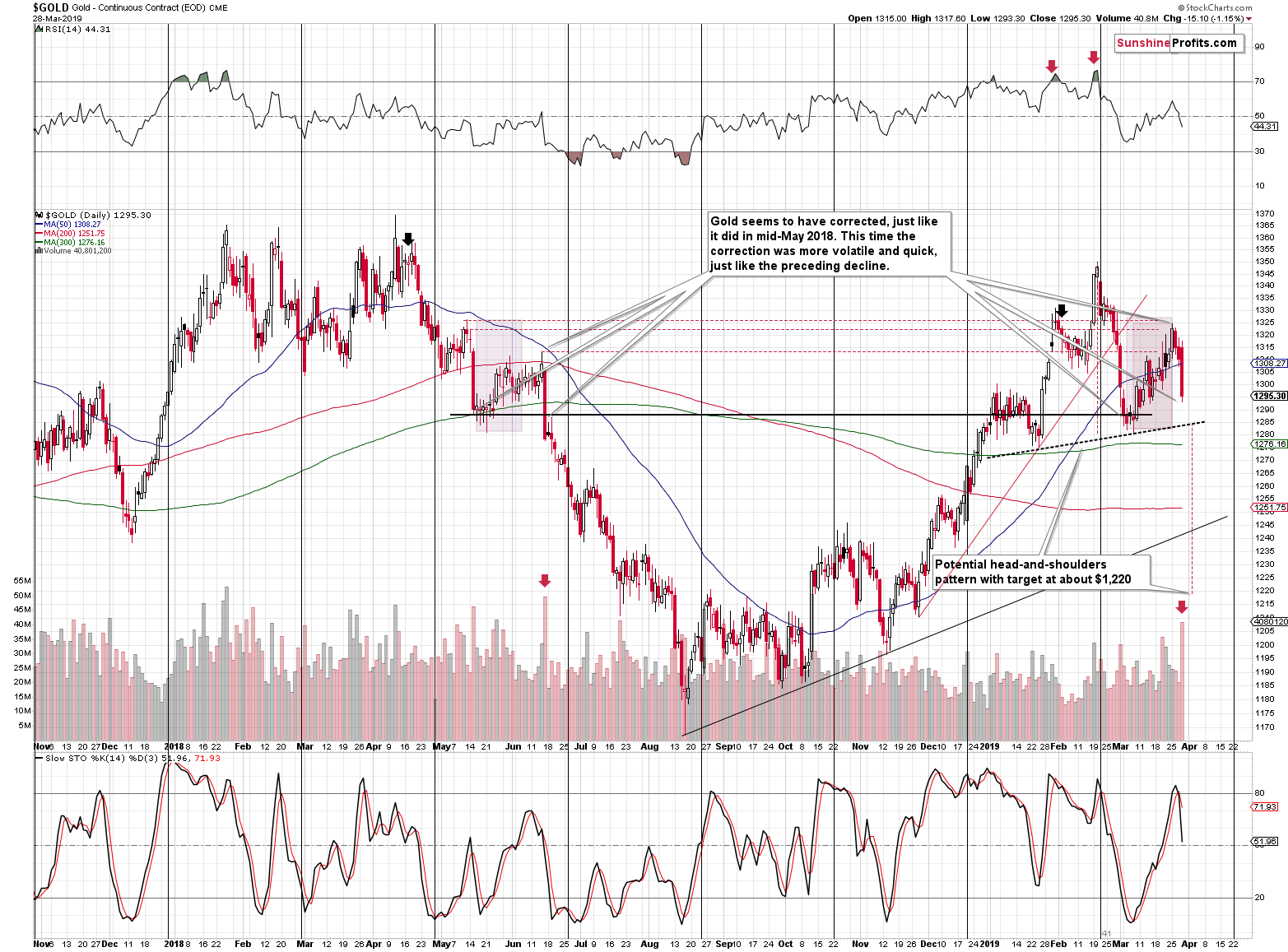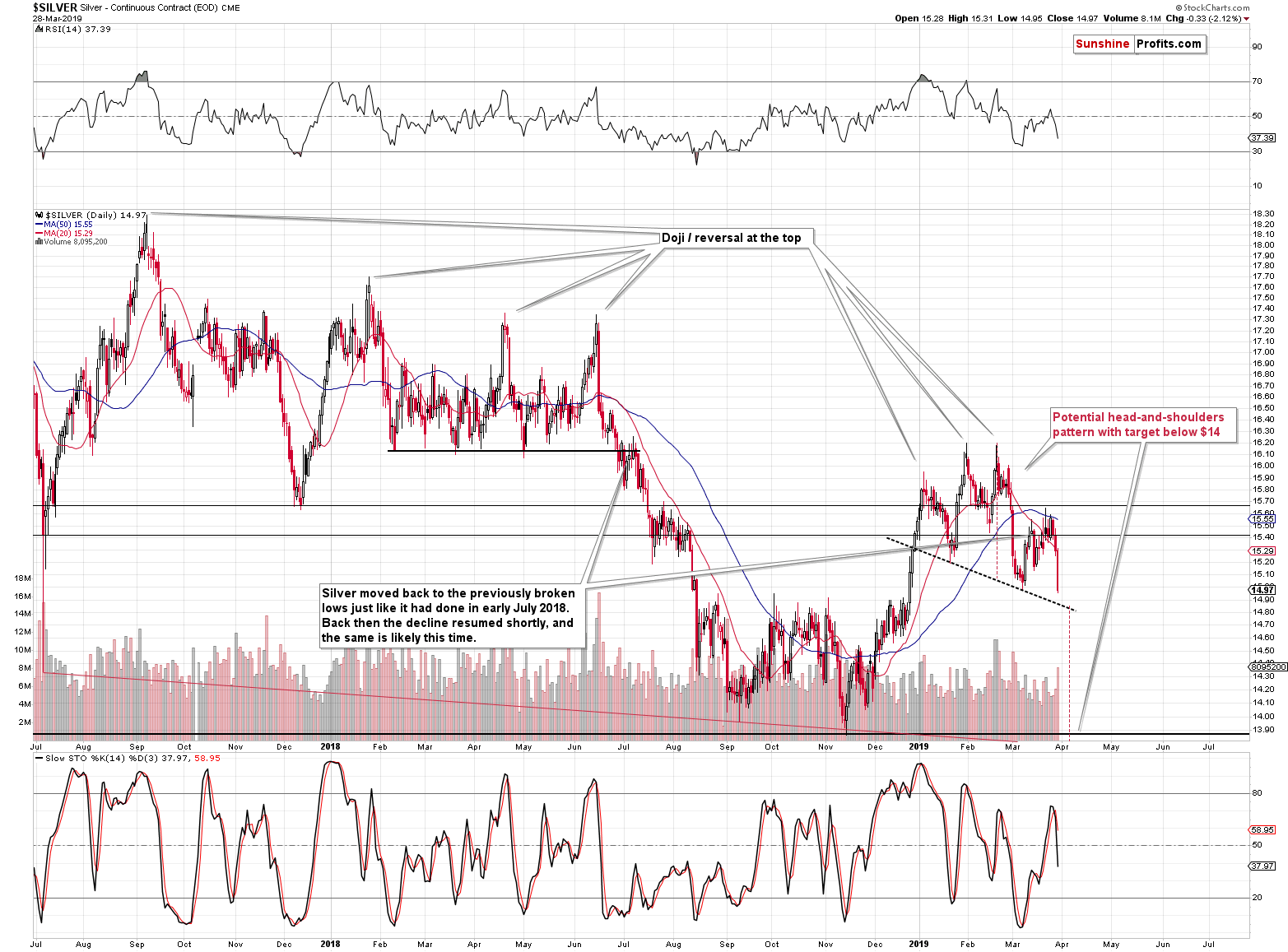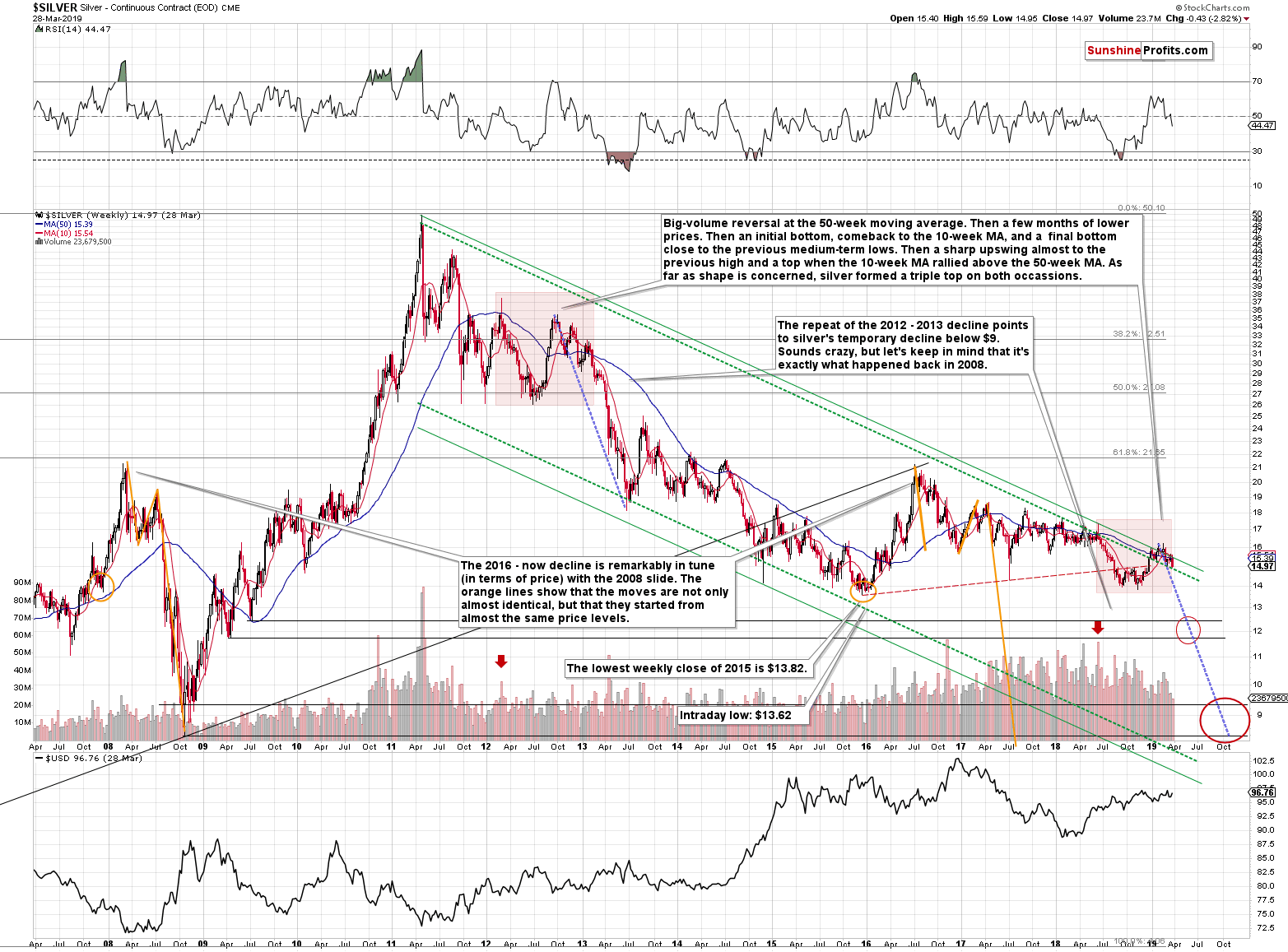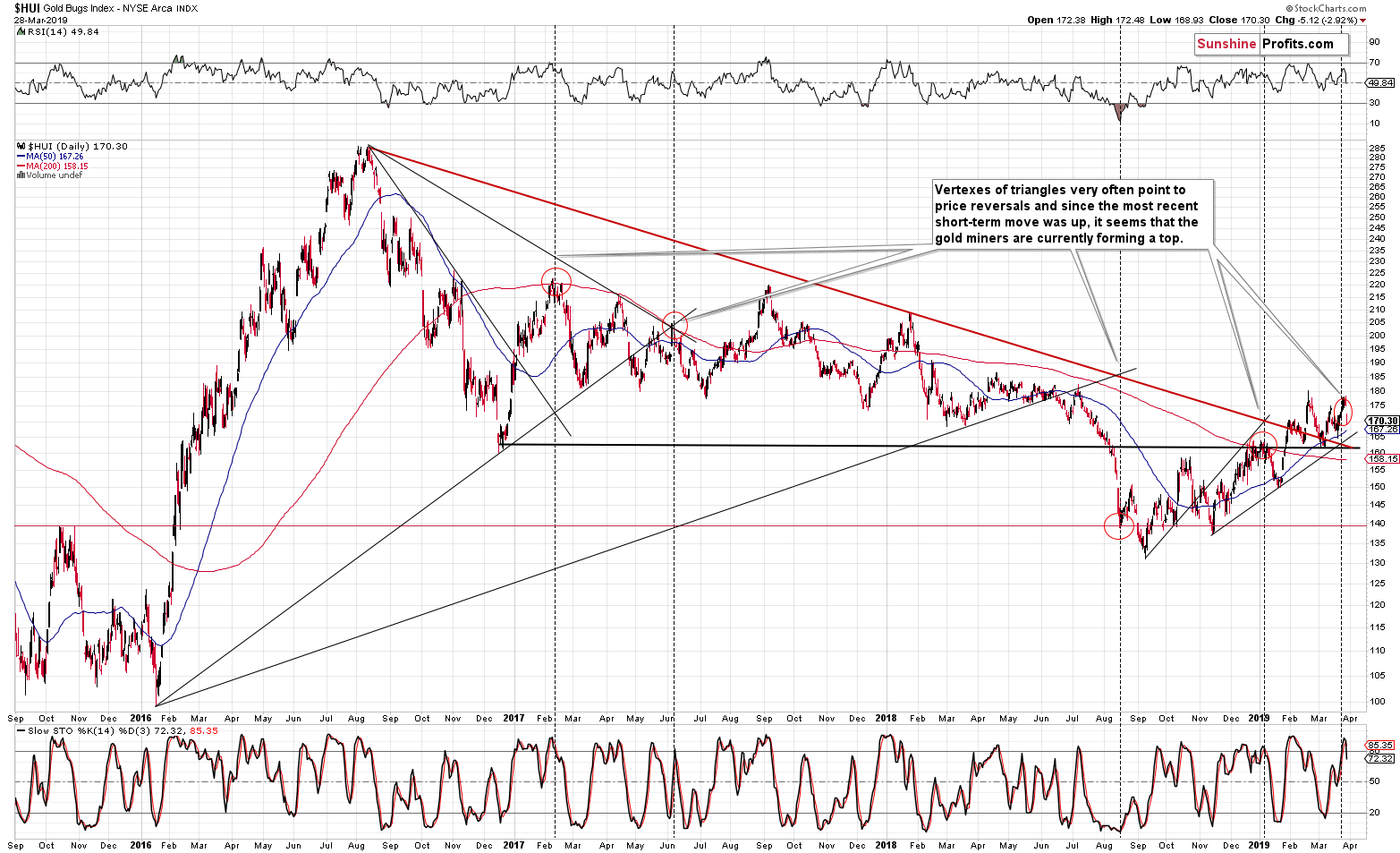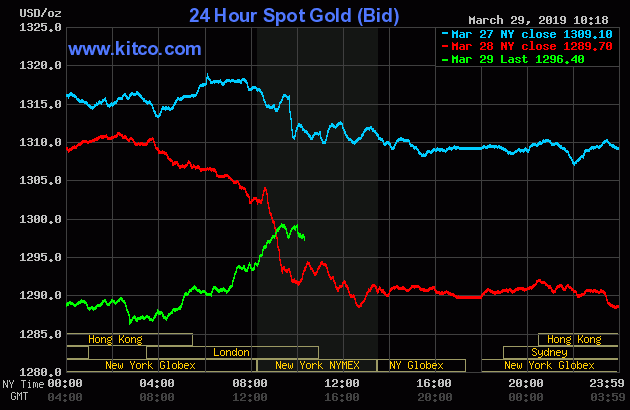Briefly: in our opinion, full (250% of the regular size of the position) speculative short position in gold, silver, and mining stocks is justified from the risk/reward perspective at the moment of publishing this Alert.
Yesterday, we have seen a bloodbath throughout the precious markets arena. Red, red, everywhere one looks. After yesterday’s slide, gold and silver are making a comeback today. Can the bulls breathe a sigh of relief, is it over now? The mining stocks provide an interesting and timely answer here. Let’s examine the full picture of this very moment as we have wanted to keep abreast of the start to the U.S. session and share with you what kind of outlook exactly that brings to the here and now.
Let’s start with gold. The yellow metal didn’t decline as substantially as palladium (yet), but it did slide on year’s highest daily volume.
Assessing the Gold Chart
The big-volume slide is not surprising, because we already wrote that the previous upswing was a correction that was similar to what we had seen in May and early June, 2018. The difference is that this time, the upswing was bigger in terms of price and smaller in terms of time. In other words, it was more volatile. No wonder – the preceding move has also been more volatile this time. This means that the move that follows can be sharper as well.
The analogy to what happened from early June to mid-August 2018 is only one of the reasons for it. The sell signal from the Stochastic indicator, the situation in the currency market, and the way in which gold failed to rally in response to Fed’s dovish surprise provide strong enough confirmations of the bearish case for the short term.
The decline could be sharp based on the possible head-and-shoulders pattern. At times, these formations are less than perfectly formed, but still retain the overall shape. In this case, the head part of the pattern was created by 2 separate tops instead of just one. Naturally, this formation is not yet complete, so there are not bearish implications thereof, but the fact that it might be completed has very interesting implications. Namely, when gold breaks below the rising, dashed neck level, and confirms this breakdown, the next target will be based on the size of the head and it will be at about $1,120.
The decline that we saw in June 2018 was quite sharp, and if the current one is even sharper, then we might see a big downswing shortly. Let’s keep in mind that based on the Fibonacci retracement levels, there is a strong support at about $1,240 – at the 61.8% retracement, so it might be the case that this level stops the decline, not the above-mentioned $1,220. Or, we might see an intraday low close to $1,220 and the closing price at about $1,240, which would cover both support levels. Either way, gold below $1,240 might provide us with an opportunity to temporarily exit our short positions, or even go long. We’ll keep you informed.
Another interesting thing about the head-and-shoulders pattern is that we can also see it in silver.
Head and Shoulders in the Making: In Silver, Too?
In case of the white metal, the target based on the head of the pattern suggests a move below $14 – to about $13.80. Sounds surprising? After all, silver was above $16 about a month ago. That’s simply what silver is – volatile. And it’s particularly volatile during declines, which is very harmful to beginning traders as they are not aware of this trait and are usually surprised by it.
Not only is silver’s move to $14 not surprising – it’s just the start.
The first strong resistance that’s reasonably low, is close to the $11.50 - $12.50 area. The 2018 and 2015 bottoms are theoretically strong support levels, but given the confirmed breakout in the gold to silver ratio and the size of the likely downswing in gold, and upswing in the USD Index, it’s difficult to picture silver dropping only to the above-mentioned levels.
Surely, these are the levels where silver might pause and correct for several days, or up to a few weeks. However, it’s unlikely that we’ll see a really major bottom once the white metal moves there and that is followed by a meaningful rally. A repeat of this year’s rally seems very unlikely in the near future.
Gold Miners: Where Is The Short-term Strength?
Gold miners showed strength on a short-term basis, but this period seems to have ended. Yesterday’s decline shortly after miners’ triangle-vertex-based reversal shows that miners are responding to gold’s weakness. They have likely gained more recently because of the way interest rates affect companies’ cost structure, but this effect seems to have been only temporary.
Once miners break below the combination of support levels slightly above 160, the decline is likely to accelerate. The declining red support line, the rising black support line and the horizontal black line based on the previous lows (December 2016, February 2019, March 2019) and highs (December 2018, January 2019) together provide relatively strong support, however, given the likely decline in gold and silver, it’s not likely to hold.
Today’s Intra-day Action
We are posting today’s Alert a bit later than our regular schedule as we wanted to provide you with the most up-to-date analysis in light of the pre-market upswing. Just as it seemed likely, gold simply moved back to the previously broken support level and verified it as resistance.
The psychologically-important $1,300 barrier stopped the rally and the early action in the mining stocks confirms the bearish outlook. The GDX ETF initially moved up by $0.24, but it erased most of this rally and is currently up by only $0.06. The miners’ short-term underperformance seems to be back and the implications for the following days are bearish.
Summary
Summing up, it’s almost certain that the next big move lower has already begun and that the 2013-like slide is in its early stage. Gold’s and miners’ very weak reaction to Fed’s surprisingly dovish remarks strongly confirms the bearish outlook for the following weeks and we can say the same thing about the size of yesterday’s decline in gold and volume that accompanied it.
As we explained last Friday, if gold declines to $1,240, this might be an opportunity to go long, but it’s too early to say for sure at this time.
To summarize:
Trading capital (supplementary part of the portfolio; our opinion): Full short position (250% of the full position) in gold, silver, and mining stocks is justified from the risk/reward perspective with the following stop-loss orders and exit profit-take price levels:
- Gold: profit-take exit price: $1,062; stop-loss: $1,357; initial target price for the DGLD ETN: $82.96; stop-loss for the DGLD ETN $39.87
- Silver: profit-take exit price: $12.32; stop-loss: $16.44; initial target price for the DSLV ETN: $47.67; stop-loss for the DSLV ETN $23.68
- Mining stocks (price levels for the GDX ETF): profit-take exit price: $13.12; stop-loss: $24.17; initial target price for the DUST ETF: $76.87; stop-loss for the DUST ETF $15.47
Note: the above is a specific preparation for a possible sudden price drop, it does not reflect the most likely outcome. You will find a more detailed explanation in our August 1st Alert. In case one wants to bet on junior mining stocks’ prices (we do not suggest doing so – we think senior mining stocks are more predictable in the case of short-term trades – if one wants to do it anyway, we provide the details), here are the stop-loss details and target prices:
- GDXJ ETF: profit-take exit price: $17.52; stop-loss: $35.67
- JDST ETF: initial target price: $143.87 stop-loss: $30.97
Long-term capital (core part of the portfolio; our opinion): No positions (in other words: cash)
Insurance capital (core part of the portfolio; our opinion): Full position
Whether you already subscribed or not, we encourage you to find out how to make the most of our alerts and read our replies to the most common alert-and-gold-trading-related-questions.
Please note that the in the trading section we describe the situation for the day that the alert is posted. In other words, it we are writing about a speculative position, it means that it is up-to-date on the day it was posted. We are also featuring the initial target prices, so that you can decide whether keeping a position on a given day is something that is in tune with your approach (some moves are too small for medium-term traders and some might appear too big for day-traders).
Plus, you might want to read why our stop-loss orders are usually relatively far from the current price.
Please note that a full position doesn’t mean using all of the capital for a given trade. You will find details on our thoughts on gold portfolio structuring in the Key Insights section on our website.
As a reminder – “initial target price” means exactly that – an “initial” one, it’s not a price level at which we suggest closing positions. If this becomes the case (like it did in the previous trade) we will refer to these levels as levels of exit orders (exactly as we’ve done previously). Stop-loss levels, however, are naturally not “initial”, but something that, in our opinion, might be entered as an order.
Since it is impossible to synchronize target prices and stop-loss levels for all the ETFs and ETNs with the main markets that we provide these levels for (gold, silver and mining stocks – the GDX ETF), the stop-loss levels and target prices for other ETNs and ETF (among other: UGLD, DGLD, USLV, DSLV, NUGT, DUST, JNUG, JDST) are provided as supplementary, and not as “final”. This means that if a stop-loss or a target level is reached for any of the “additional instruments” (DGLD for instance), but not for the “main instrument” (gold in this case), we will view positions in both gold and DGLD as still open and the stop-loss for DGLD would have to be moved lower. On the other hand, if gold moves to a stop-loss level but DGLD doesn’t, then we will view both positions (in gold and DGLD) as closed. In other words, since it’s not possible to be 100% certain that each related instrument moves to a given level when the underlying instrument does, we can’t provide levels that would be binding. The levels that we do provide are our best estimate of the levels that will correspond to the levels in the underlying assets, but it will be the underlying assets that one will need to focus on regarding the signs pointing to closing a given position or keeping it open. We might adjust the levels in the “additional instruments” without adjusting the levels in the “main instruments”, which will simply mean that we have improved our estimation of these levels, not that we changed our outlook on the markets. We are already working on a tool that would update these levels on a daily basis for the most popular ETFs, ETNs and individual mining stocks.
Our preferred ways to invest in and to trade gold along with the reasoning can be found in the how to buy gold section. Additionally, our preferred ETFs and ETNs can be found in our Gold & Silver ETF Ranking.
As a reminder, Gold & Silver Trading Alerts are posted before or on each trading day (we usually post them before the opening bell, but we don't promise doing that each day). If there's anything urgent, we will send you an additional small alert before posting the main one.
=====
Latest Free Trading Alerts:
Do you want to protect your capital against recession? Great, just like us and millions of other people. The key questions is, thus, how to predict that the danger is coming. We invite you to read our today’s article and find out what are key recession indicators – and their relationship with the price of gold.
Key Recession Indicators and Gold
The U.S. dollar is on the move and many currency pairs are feeling the heat. Keeping a watchful eye on the hints dropped along the way is a surefire way to gain. The pairs of our interest have been building upon their recent moves to our satisfaction and if not exactly very strongly, we’ve found an elegant and beneficial way to deal with the situation anyway. Just take a look and be inspired by the actionable details below – just like our subscribers are every trading day.
With the USD Rising, Has The Harvest Time Come Now?
=====
Thank you.
Sincerely,
Przemyslaw Radomski, CFA
Editor-in-chief, Gold & Silver Fund Manager


